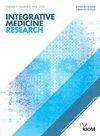电针神门穴和内关穴对慢性部分睡眠剥夺人群脑功能改变的BOLD-fMRI研究
IF 3
4区 医学
Q2 INTEGRATIVE & COMPLEMENTARY MEDICINE
引用次数: 0
摘要
本研究旨在探讨电针针刺神门穴(HT7)和内关穴(PC6)如何通过调节脑功能改善慢性部分睡眠剥夺(CPSD),并利用静息状态血氧水平依赖功能磁共振成像(BOLD-fMRI)阐明其潜在的神经机制。方法招募CPSD参与者43例和健康对照48例,在电针治疗前进行神经心理评估。3.0T BOLD-fMRI扫描分别于双侧HT7、PC6电针前后进行。分析两组患者电针前后的低频波动幅度(ALFF)、区域均匀性(ReHo)值及功能连通性。结果与HC相比,scpsd患者反应时间(RT)延长,漏检率(OR)升高,反应正确率(ACC)降低。电针前后各组间ALFF、ReHo、功能连通性差异有统计学意义(P < 0.05),特别是在默认模式网络(DMN)和边缘系统。右侧海马旁回ALFF与ACC呈正相关(r = 0.637, P = 0.001),与OR呈负相关(r = -0.427, P = 0.047)。左侧额上回ReHo与RT呈负相关(r = -0.514, P = 0.014)。结论CPSD破坏脑功能活动,而电针HT7和PC6调节静息状态脑功能,为其治疗CPSD患者情绪和认知障碍的潜在机制提供了神经影像学见解。本文章由计算机程序翻译,如有差异,请以英文原文为准。
Brain functional changes in chronic partial sleep-deprivation population by electroacupuncture at shenmen(HT7) and neiguan (PC6) acupoints: A BOLD-fMRI study
Background
The aim of this study is to explore how electroacupuncture at the Shenmen (HT7) and Neiguan (PC6) acupoints can improve chronic partial sleep deprivation(CPSD) by regulating brain function, and to elucidate its potential neural mechanisms using resting state Blood Oxygen Level-Dependent functional magnetic resonance imaging (BOLD-fMRI).
Methods
43 CPSD participants and 48 healthy controls (HC) were recruited and underwent neuropsychological assessments before electroacupuncture. 3.0T BOLD-fMRI scans were conducted before and after receiving bilateral electroacupuncture at HT7 and PC6. Amplitude of low-frequency fluctuation (ALFF) regional homogeneity (ReHo) values and functional connectivity were analyzed between two groups before and after electroacupuncture.
Results
CPSD participants showed prolonged reaction time (RT), increased omission rate (OR), and decreased accuracy (ACC) compared to HC. Significant differences (P < 0.05) in ALFF, ReHo, and functional connectivity were observed between groups before and after electroacupuncture, particularly in the default mode network (DMN) and limbic system. ALFF in the right parahippocampal gyrus positively correlated with ACC (r = 0.637, P = 0.001) and negatively with OR (r = -0.427, P = 0.047). ReHo in the left superior frontal gyrus negatively correlated with RT (r = -0.514, P = 0.014).
Conclusion
CPSD disrupts functional brain activity, while electroacupuncture at HT7 and PC6 modulates resting-state brain function, offering neuroimaging insights into its potential mechanisms for treating emotional and cognitive impairments in CPSD.
求助全文
通过发布文献求助,成功后即可免费获取论文全文。
去求助
来源期刊

Integrative Medicine Research
Medicine-Complementary and Alternative Medicine
CiteScore
6.50
自引率
2.90%
发文量
65
审稿时长
12 weeks
期刊介绍:
Integrative Medicine Research (IMR) is a quarterly, peer-reviewed journal focused on scientific research for integrative medicine including traditional medicine (emphasis on acupuncture and herbal medicine), complementary and alternative medicine, and systems medicine. The journal includes papers on basic research, clinical research, methodology, theory, computational analysis and modelling, topical reviews, medical history, education and policy based on physiology, pathology, diagnosis and the systems approach in the field of integrative medicine.
 求助内容:
求助内容: 应助结果提醒方式:
应助结果提醒方式:


